NVIDIA GeForce GTX 670 Review Feat. EVGA: Bringing GK104 Down To $400
by Ryan Smith on May 10, 2012 9:00 AM ESTOC: Power, Temperature, & Noise
Our final task is our look at GTX 670’s overclocking capabilities. Based on what we’ve seen thus far with GTX 670, it looks like NVIDIA is binning chips based on functional units rather than clockspeeds. As a result GTX 670 could have quite a bit of overclocking potential, albeit one still limited by the lack of voltage control.
| GeForce 600 Series Overclocking | |||||
| GTX 670 | EVGA GTX 670SC | GTX 680 | |||
| Shipping Core Clock | 915MHz | 967MHz | 1006MHz | ||
| Shipping Max Boost Clock | 1084MHz | 1188MHz | 1110MHz | ||
| Shipping Memory Clock | 6GHz | 6GHz | 6GHz | ||
| Shipping Max Boost Voltage | 1.175v | 1.162v | 1.175v | ||
| Overclock Core Clock | 1065MHz | 1042MHz | 1106MHz | ||
| Overclock Max Boost Clock | 1234MHz | 1263MHz | 1210MHz | ||
| Overclock Memory Clock | 6.9GHz | 6.6GHz | 6.5GHz | ||
| Overclock Max Boost Voltage | 1.175v | 1.162v | 1.175v | ||
Because of the wider gap between base clock and boost clock on the GTX 670 we see that it doesn’t overclock quite as far as GTX 680 from a base clock perspective, but from the perspective of the maximum boost clock we’ve slightly exceeded the GTX 680. Depending on where a game lands against NVIDIA’s power targets this can either mean that an overclocked GTX 670 is faster or slower than an overclocked GTX 680, but at the same time it means that overclocking potential is clearly there.
We’re also seeing another strong memory overclock out of a GK104 card here. GTX 680 only hit 6.5GHz while GTX 690 could hit 7GHz. GTX 670 is only a bit weaker at 6.9GHz, indicating that even with the relatively small PCB that NVIDIA can still exceed the high memory clocks they were shooting for. At the same time however this is a luck of the draw matter.
The EVGA card meanwhile fares both worse and better. Its gap between the base clock and and maximum boost clock is even larger than the reference GTX 670, leading to it having an even lower overclocked base clock but a higher overclocked maximum boost clock. The real limiting factor however is that it couldn’t reach a memory overclock quite as high as the reference GTX 670 – again, luck of the draw – which means it can’t match the overclocked reference GTX 670 as it’s going to be more memory bandwidth starved more often.
Moving on to our performance charts, we’re going to once again start with power, temperature, and noise, before moving on to gaming performance. We’ll be testing our GTX 670 cards at both stock clocks with the maximum power target of 122% (170W) to showcase what is possible at validated clockspeeds with a higher power cap, and a true overclock with a maximum power target along with the largest clock offsets we can achieve.
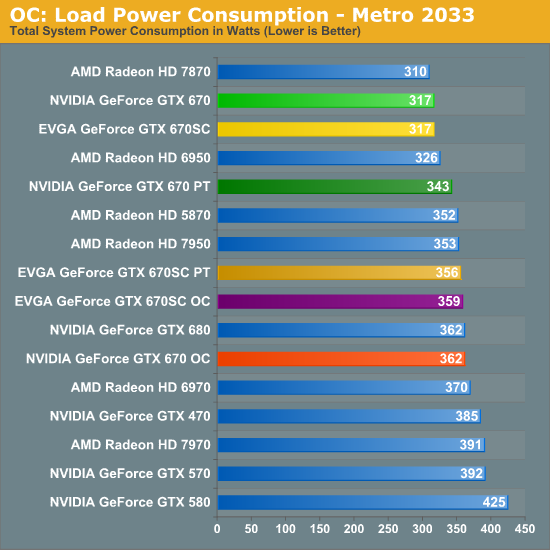
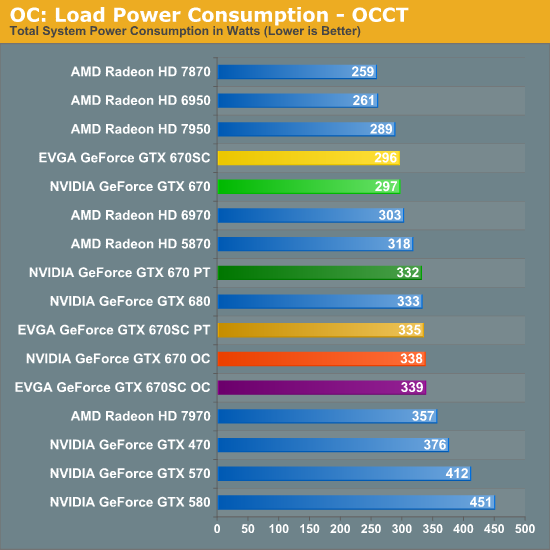
Not surprisingly, since we’re almost always operating within the realm of the power target as opposed to the TDP on the GTX 600 series, our power consumption closely follows our chosen power target. Cranking up the power target on the GTX 670 for example to 170W puts us within 6W of the GTX 680, which itself had a 170W power target in the first place. This is true for both Metro and OCCT, which means power consumption is very predictable when doing any kind of overclocking.
This also means that power consumption is still 18W-30W below the 7970, which in turn means that if these overclocks can close the performance gap, then the GTX 670 still has a power consumption advantage.
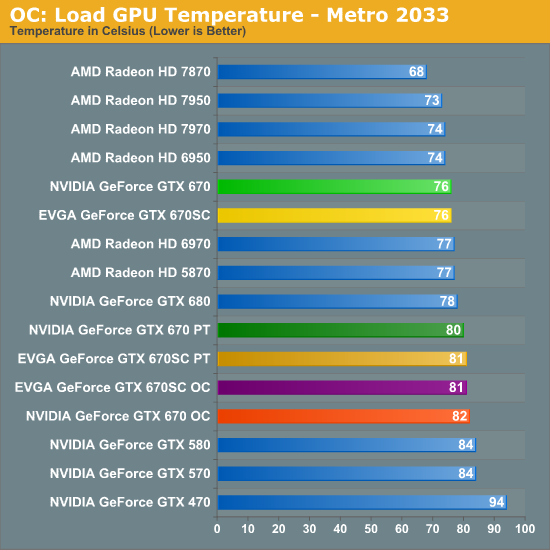
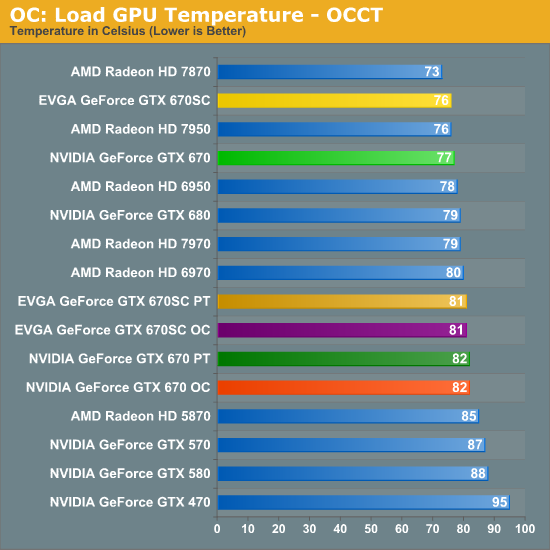
As to be expected, with an increase in power consumption comes an increase in load temperatures. However the fact that we’re only able to increase power consumption by about 30W means the temperature rise is limited to 4-5C, pushing temperatures into the low 80s. This does end up being warmer than the equivalent GTX 680 however due to the 680’s superior heatsink.
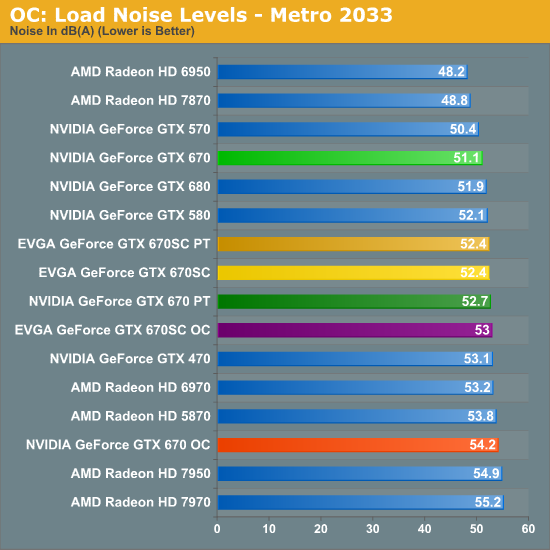

Finally, when it comes to noise we’re also seeing the expected increase, but again it’s rather small. Under Metro the amount of noise from the reference GTX 670 rises by under 3dB when pushing the power target higher on its own, while it rises 3dB when adding in our full overclock. Again the smaller cooler means that the GTX 670’s fan has to work harder here, which means our gaming performance may be able to reach the GTX 680, but our noise is going to slightly exceed it. As a point of reference, in the process we’ll also exceed the GTX 580’s noise levels under Metro. Still, in both OCCT and Metro none of our GTX 670 cards exceed the Radeon HD 7900 series, which means we've managed to increase our performance relative to those cards without breaching the level of noise they generate in the first place.










414 Comments
View All Comments
CeriseCogburn - Friday, May 11, 2012 - link
Here we are treated to 5 paragraphs of attack on the 600 series, note the extreme phrasing given against, the "known problem" of the GTX cards, not the "inexplicable" results that means something is wrong other than with the amd card when it loses.This contrasts with the bland put downs the 670 compared to the 680 and 570 receive when they win by enormous comparative margins in the rest of the game pages.
So the reviewer has a field day here:
" Overall performance isn’t particularly strong either. Given the price tag of the GTX 670 the most useful resolution is likely going to be 2560x1600, where the GTX 670 can’t even cross 30fps at our enthusiast settings."
Completely unmentioned of course after the jab at pricing just for the 670, same price as the 7950 that fares not playably better here and gets spanked the other 75% of time, is the 5760x1200 higher resolution where the 670 achieves even higher frame rates than 30, surpassing 30 all the way up to 35.6, just below 35.8 for the 7950, two tenths of one frame.
Somehow, that isn't mentioned, only the lower 2560 resolution with lower frame rates (for all the cards) but the 670 singled out as the only card that has peaked at "given the price".
Later in the review completely unplayable frame rates for all cards in a test is used to attack just the 570, too, for lack of memory. Forget the fact that none of the other cards had playable frame rates.
Eye candy was turned down at the triple monitor resolution but that has never before made 2560 most useful for reviews here, especially with lower frame rates for all the cards tested at the lower resolution settings. Only when we can cut down nVidia is such a statement useful, and it is very definitely confined to just the nVidia card then.
So avoided is the paltry frames of the other competing cards even at "easier" 5670 settings.
If the 670 is no good past 2560, then neither are any of the other cards at all, except the 7970 ? Maybe the reviewer suddenly has decided 5670 gaming is no good.
" Even 1920x1200 isn’t looking particularly good. This is without a doubt the legitimate lowpoint of the GTX 670. "
Well, then the 7950 doesn't look good at 1920 either, less than 1 fps difference, not to mention the 680 that is within in couple frames.
If we take the reviewers words with their total meaning, what we have is the unsaid statement that - only possibly the 7970 should be used for this game at 5670, no other card though.
Now - a total examination of the Crysis Warhead gaming page fps charts reveals this:
Every card is unplayable at every resolution except for the latest respective releases in 1920X1200 chart.
BrunoLogan - Friday, May 11, 2012 - link
... still unreachable for me on what budget is concerned. The 660Ti is what I'm looking for but as I saw somewhere it may be 5 or 6 months away and I don't know if I can wait that long. My old C2D need's replacement. I may just grab a 560Ti and later down the road get 760Ti skipping 6xx generation... bittersweet :-\
shin0bi272 - Friday, May 11, 2012 - link
what gpu do you have now? You said you need to upgrade your core 2 cpu but didnt say what you have for a gpu.Im still running a gts 250 and getting pretty good fps on everything but BF3 at pretty high specs on a 19x12 monitor. Your major issue with games today is they are made for consoles with dx9 cards in them that came out in 2006. So with some exceptions (crysis, metro 2033, and bf3 for example) you dont really need a huge card for anything other than playing all the new games at max spec. Sure everyone wants to do that but you dont necessarily NEED to. I played metro2033 and had physx on and it was easily playable in the 30-40 fps range.
So if you upgrade your cpu (which btw you really only need to upgrade to a quad core if its a gaming rig to get the max fps a cpu upgrade wil give you) and keep your current gpu and then when money allows grab a 670 or 685 or whatever AMD has to offer in your price range.
BrunoLogan - Friday, May 11, 2012 - link
Do you really want to know? I have a 9600GT :-P Also, I can't call it an upgrade as in "adding some new parts and keeping some of the existing ones". I'm really buying a new machine PSU and tower included. That's why I say it's bittersweet to buy a new machine with previous generation graphics.shin0bi272 - Monday, May 14, 2012 - link
hmmm well see what you have for cash left over after buying the important parts. Honestly buying a new system now is a good idea. Ivy bridge being released which drops the prices of sandy bridge (which as I said before will give you the same FPS in game) and even throwing $125 at a 550ti will be a good jump till the end of summer when the 685 comes out, and the 550 wouldnt give you the best fps so youd still be wanting to upgrade.shin0bi272 - Monday, May 14, 2012 - link
oh and a gts250 is a rebadged and die shrunk 8800gtxmedi01 - Saturday, May 12, 2012 - link
Hard to justify buying 560Ti, unless you somehow decided to only by nVidia.7850 consumes much less power while being ahead performance wise.
CeriseCogburn - Saturday, May 12, 2012 - link
7850 costs more, and has the massive disadvantage of being plagued with the now featureless in comparison amd crash pack latest, 12.4, to be followed on by another disaster within a months time.medi01 - Sunday, May 13, 2012 - link
Why don't you kill yourself, dear nVidia zealot with a lot of time to post utter nonsense?CeriseCogburn - Sunday, May 13, 2012 - link
LOL - hey man the facts aren't issues to be sad about.If I get depressed I'll let you know so you can help. :)